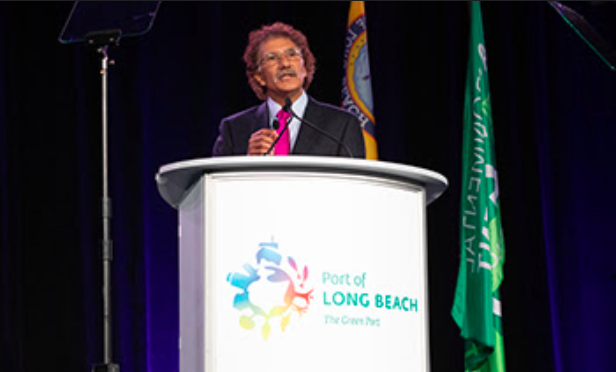 The Port of Long Beach is inching closer to its pioneering goals for rail—all part of an effort to create a greener and more efficient port. At the annual State of the Port address, Mario Cordero announced several plans to expand and improve the Port of Long Beach's dock rail system, including a $1 billion commitment from the Harbor Commission for train improvements. The port has a long-term goal of moving 50% of all cargo by dock rail, but these improvements, once complete, will bring the port to 35% this year.
The Port of Long Beach is inching closer to its pioneering goals for rail—all part of an effort to create a greener and more efficient port. At the annual State of the Port address, Mario Cordero announced several plans to expand and improve the Port of Long Beach's dock rail system, including a $1 billion commitment from the Harbor Commission for train improvements. The port has a long-term goal of moving 50% of all cargo by dock rail, but these improvements, once complete, will bring the port to 35% this year.
“This is visionary. This port is taking the lead in rail,” Cordero, executive director at the Port of Long Beach, said at the State of the Port address. “Rail allows us to move goods to and from all major US markets much faster than cargo through the Gulf and East Coast ports. This is true of imports and exports.”
The improvements will also include the so-called Pier V project, which will build a second rail track from Pier V to Pier J. The port also plans to close the 9th Street crossing in March, which Cordero said will help trains to move faster and more efficiently. We are furthering our commitment to on dock rail and operational excellence,” he said, adding that the benefits of rail are ample. “The delivery of containers to and from ships by train is the most sustainable and efficient way to move cargo in and out of the port. Each train eliminates as many as 750 truck trips, speeding the flow of goods and cutting traffic on roadways. Train is a big part of our green future.”
This is not a new concept for the port. These projects are built on long transition toward sustainability. “Last year, I referenced an Amazon state of mind—the idea that we need to innovate, lead and find better ways to move cargo more efficiently. Our customers demand this,” added Cordero about the need to keep moving forward and innovating. “Vessels are getting larger and trains are getting longer.”
The port is also leveraging technology to accomplish its lofty goals. In 2018, the port began to use information technology to create more efficiency unloading cargo while simultaneously providing better service. “All of our terminals are looking for ways to speed their operations,” he explained. “For that, truck appointments are essential, and we must strive for a universal appointment system, as called for in the 2017 clean air action plan. Today, our terminals are beginning to use informational technology to provide better service.”
These technologies include predictive analytics that let cargo owners and motor carriers can know five days before a vessel arrives when their cargo will be ready for pick up and optimization tools. “This could give our customers the visibility to make appointments, improve truck turn times, reduce how long containers sit at our terminals and lower cargo handling costs,” Cordero said.
© Touchpoint Markets, All Rights Reserved. Request academic re-use from www.copyright.com. All other uses, submit a request to [email protected]. For more inforrmation visit Asset & Logo Licensing.






